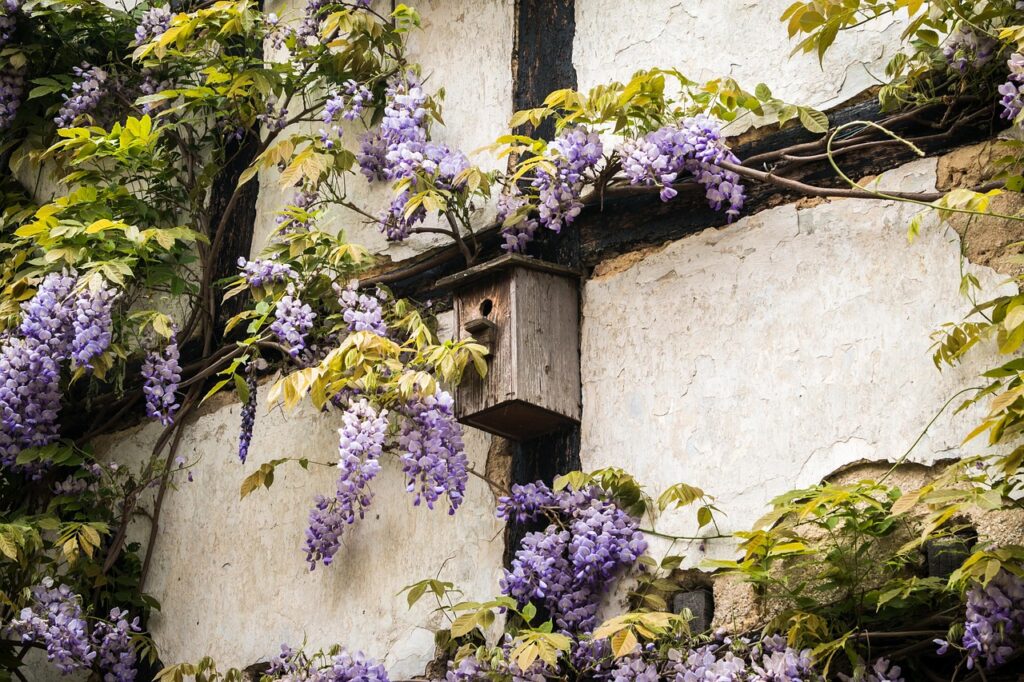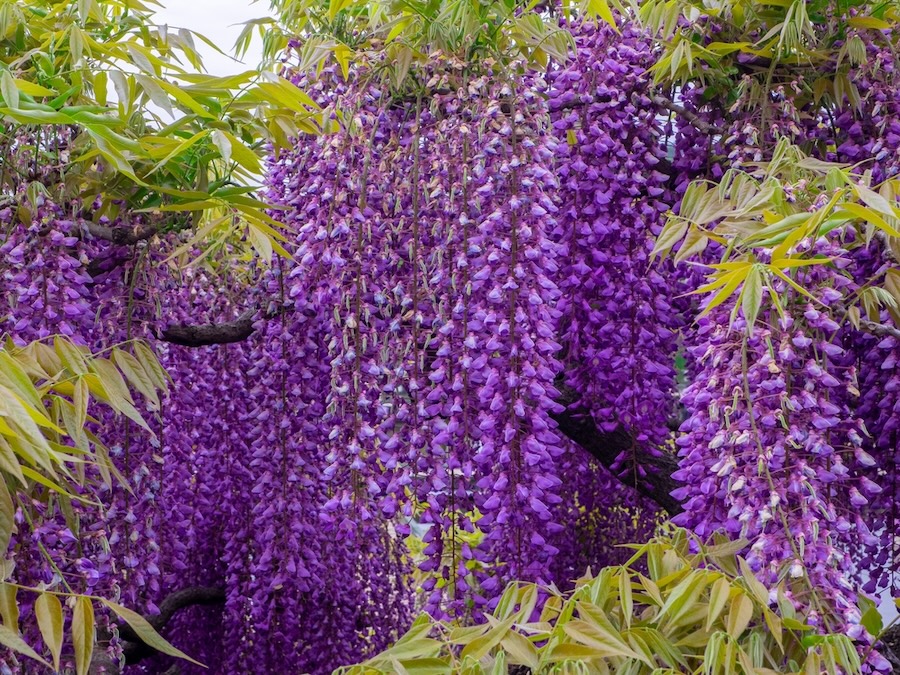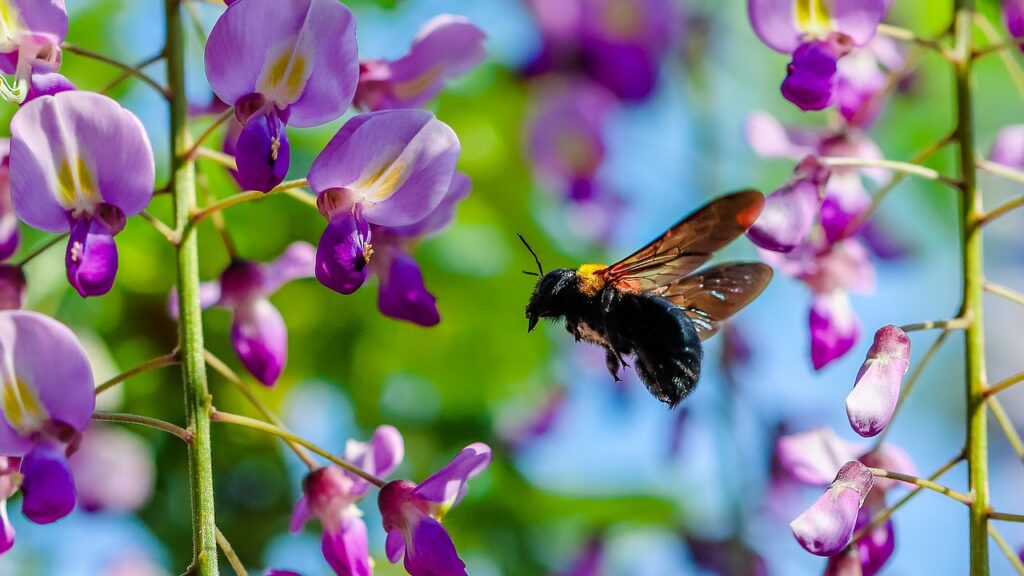Log in or create new account to save this product to your wishlist.

Pruning Wisteria: When, Why, & How?
Get the most out of your wisteria with our useful tips. Learn the art of pruning wisteria - when, how & why for optimal best results.
🌱 All important maintenance moments for your lawn during the year. Leave your email and we will send you the lawn calendar for free.
Enter your email
Receive the lawn calendar in the mail
Enjoy a green lawn all year round!

- Order by 2PM = shipped today
- 250.000+ satisfied customers!
- 60 day satisfaction guarantee
Has your Wisteria become unwieldy? Is it growing over other plants? Perhaps it has started growing over your windows, blocking out the daylight from your home. It’s time for pruning wisteria!
- Why is pruning wisteria important?
- Optimal Timing for Pruning Wisteria
- Essential Tools for Pruning Wisteria
- A step-by-step guide to pruning Wisteria
- Common Mistakes to Avoid While Pruning Wisteria
- Winter Pruning for Wisteria
- Four Strategies to Maintain Healthy Wisteria
- Ways to train Wisteria
- FAQs
This beautiful climbing plant is known for its spectacular flowering. But to ensure your plant remains healthy and abundant, it’s vital to prune twice a year.
In this step-by-step guide, we’ll show you how to prune your Wisteria for stunning results.
Ready? Let’s get started!
Why is pruning wisteria important?

Pruning wisteria is crucial for stimulating new shoot growth and flower bud production, ensuring a robust and well-formed plant. Regular pruning helps manage its size, preventing it from overwhelming nearby plants and degrading air circulation.
Moreover, pruning wisteria enhances its flowering capacity by allowing the plant to concentrate its resources on generating fresh blooms, leading to a more extended and fuller flowering period.
Optimal Timing for Pruning Wisteria

The first cut should be in summer, after the plant has completed its flowering cycle, trimming side branches to approximately 8 inches. — usually in July or August.
The second prune occurs in late winter or early spring – before new growth sprouts in January or February. During this dormant period, the plant is less prone to sap ‘bleeding’ and can handle more substantial pruning, shortening branches to about 12 inches from the main trunk. Cut back to two to three buds.
Essential Tools for Pruning Wisteria

To prune Wisteria effectively, you’ll need a few specific tools:
- Sharp Pruning Shears: For precise cuts on branches and twigs.
- Branch Shears: For cutting thicker branches that regular shears can’t handle.
- Ladder: For reaching higher branches if your Wisteria has grown tall.
A step-by-step guide to pruning Wisteria

Step 1: Good Preparation
Gather your clean, sharpened pruning shears, branch shears, and a ladder if necessary.
Step 2: Remove Dead and Damaged Branches
Trim dead or damaged branches back to the main trunk.
Step 3: Prune the Side Branches
Cut the side branches back to about 50cm from the main trunk, above a bud or side shoot. Create an angled cut to help rainwater drip off the branch’s end — this helps prevent disease or mould forming at the site of the wound.
Step 4: Remove Old Flower Clusters
Clear old flower clusters to redirect energy to new bloom production.
Step 5: Shape the Plant
Prune any branches that are too long or misdirected to maintain the desired plant shape.
Step 6: Clean Up
Dispose of pruning debris promptly to avoid disease and pest issues.
Common Mistakes to Avoid While Pruning Wisteria
Avoid over-pruning, which can limit flowering. Pruning typically encourages new growth, but you’ll hinder the plant’s development if you cut back too far. Remember, leaves are a plant’s lungs and their means of converting sunlight into sugars (aka photosynthesis) — so removing too much foliage can starve the plant’s energy.
Ensure you prune at the correct time—either directly after flowering in summer or in late winter/early spring. And don’t cut back too hard in summer; otherwise, the plant will produce fewer flower buds for the next season.
Finally, make sure you prune in the right place: just above buds or side branches and at an angle for quick healing and to prevent water damage.
Winter Pruning for Wisteria
Summer pruning promotes air circulation while allowing sunlight to ripen the younger wood. On the other hand, winter pruning is about helping the plant maintain its shape and preventing it from growing too large.
The typical winter pruning technique is to cut back quite hard, leaving two or three buds on each branch. But you might need to prune older plants harder to remove old and diseased wood.
Pruning old wisteria bushes
It may be necessary to cut back long, woody branches to the main stem. If the plant is in serious need of renovation, cut it down to ground level. It might seem drastic, but the plant will rejuvenate entirely in a few years.
For older bushes, cut until you create a skeleton of well-spaced branches.
Four Strategies to Maintain Healthy Wisteria

- Provide Adequate Support: Wisteria needs a structure to climb on for proper upward growth.
- Water Generously: Keep the soil moist, especially during dry spells, without waterlogging it.
- Fertilise Regularly: Apply quality fertiliser in spring and summer to encourage growth and blooming.
- Monitor for Pests and Diseases: Wisteria can be susceptible to issues like mildew and aphids. Regularly inspect and treat as necessary.
Ways to train Wisteria
On walls
The ideal way to grow Wisteria is with an espalier – a framework of horizontal support wires, set 30cm apart. The plant will climb the wires, creating a strong spur system covering your chosen wall.
Over pergolas or arches
The long flower racemes look amazing when draping overhead, impeded by foliage or the plant’s branches. So, train your Wisteria over a pergola or lattice archway for an enchanting addition to your patio area.
FAQs
Prune twice a year—once in summer after the plant has finished flowering, then again in late winter or early spring. Remove the flower heads and any straggling branches or diseased wood in summer. The late winter/early spring pruning can be harder, cutting back to 2 or 3 buds.
Maintain your stunning wisteria plant by pruning twice a year, watering regularly, fertilising during the growing season, and checking for pests and diseases to promote healthy growth and flowering.
Post-blooming, prune excess shoots and branches from your wisteria plant. Continue with maintenance pruning, watering, and fertilising for ongoing health and future blooms.
Any questions?
Want to discover more on the art of pruning?
Pruning roses: why, when and how?
Hydrangeas 101: everything you need to know for beautiful blooms
Pruning lavender: why, when and how?
We hope to have provided all the info you might need to successfully prune your wisteria. But if you have any queries, don’t hesitate to get in touch.
Happy gardening!
-
How to Build a DIY Greenhouse: A Practical Guide for Smart SpendersImagine extending your growing season throughout the year, nurturing tender plants regardless of the weather, and creating a personal garden sanctuary. This is precisely what a DIY greenhouse offers you. Let’s learn how to build one.Read more
-
How to Grow Eucalyptus in British GardensWith a little love and care, eucalyptus trees can thrive in English gardens. Since they don’t germinate well without proper help, there are not considered invasive. So, there is no reason not to plant them if you enjoy their looks.Read more
-
Transform Your Garden with All-Year-Round Flowering PlantsDid you know you can enjoy blooming flowers even in January? With the right selection of all year round plants, there’s no need to wait until spring to add some colour to your garden.Read more
-
How to Create a Butterfly Garden: A Simple Guide for British GardensThe UK's butterfly population includes 59 different species. These beautiful winged creatures face a steady decline because of habitat loss, pollution and changing weather patterns. Your garden can become a vital link between nature reserves and natural habitats. Let’s explore how.Read more
-
Volcanic Rock Dust for Your Garden—Application and TipsDid you know that volcanic rock dust is a brilliant organic soil improver? This article explains exactly what it's good for and how to use it properly.Read more
-
How to Use Landscape Fabric ProperlyIf weeds or erosion in your garden are troubling you, landscape fabric might be the solution. We’ll explain how and when to use it properly, just keep on reading.Read more
-
Hostas: A Complete Care GuideIf you have a north-facing garden or some shady corners on your property, hostas are the plants for you. These green delights thrive particularly well in partial to full shade and require consistently moist soil to perform at their best.Read more
-
How to Grow Grapes in Your Garden: A Simple Step-by-Step GuideGrapevines produce some tasty fruits, but often they are simply grown for their gorgeous leaves. Whatever your motivation may be, we have a guide on how to grow grapes for you.Read more
Leave a comment
Your answer will be displayed on the site and the interested party will be notified by email.
Leave a comment
Have a question or want to share your experience? Leave us a comment.

- Order by 2PM = shipped today
- 250.000+ satisfied customers!
- 60 day satisfaction guarantee

- Order by 2PM = shipped today
- 250.000+ satisfied customers!
- 60 day satisfaction guarantee

- Order by 2PM = shipped today
- 250.000+ satisfied customers!
- 60 day satisfaction guarantee

🌱 All important maintenance moments for your lawn during the year. Leave your email and we will send you the lawn calendar for free.
Enter your email
Receive the lawn calendar in the mail
Enjoy a green lawn all year round!





















Comments (0)
There are no comments yet. Well then, what are you waiting for to
Be the first to write your comment!inaugurate this pretty page?
Do you have some comments?